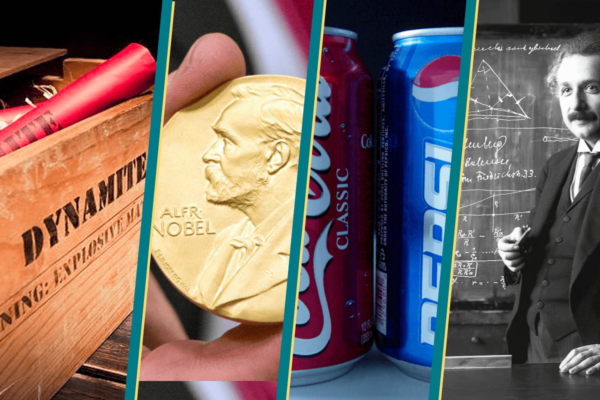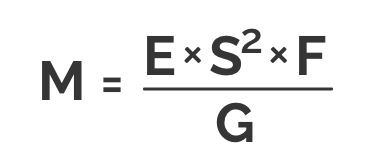Creating The Conditions for Change: The Nobel Prize, The Cola War and The Innovation Equation
— June 3, 2019

It was the 1840s in St. Petersburg when a young boy named Alfred got his first science kit. From that moment on, he was hooked. As soon as he was old enough, Alfred left for Paris, the mecca for scientific exploration. There, he met a man named Ascanio Sobrero, who invented a new chemical compound called nitroglycerine but was having trouble stabilizing it. Alfred decided to make it his project since he specialized in chemistry.
After years of experimentation, Alfred finally had a breakthrough, combining nitroglycerine with silica to produce a thick paste that was less volatile and could be molded to any shape. He called it “dynamite,” and it quickly became a sensation. Over the next few decades, Alfred developed other explosives that were widely adopted in the fields of industrial development and warfare. Soon, he became famous.

Then tragedy struck. Alfred’s brother passed away. However, the reporters got it wrong, and the next day’s newspaper listed Alfred in the obituaries, not his brother. It was not a pretty sight. Much to his dismay, Alfred realized the legacy he was leaving behind was that of damage and destruction. One paper even pronounced, “The Merchant of Death Has Died.”
Alfred was horrified. The papers soon corrected their mistake, but the damage was already done. Alfred decided he had to change his legacy. He had to change the conversation. He spent more time with family and friends. He gave to charity. He helped do good in the world, repairing any harm he may have caused.
In his final act of kindness, Alfred left all of his wealth, not to his family, but in a trust. It was set up in a way that, every year, the trust would be awarded in the form of a substantial cash prize to an individual who had done significant work furthering the cause of global peace.
The Nobel Peace Prize lives on to this very day in the name of Alfred Nobel and is one of the most prestigious science awards around the world.
You Hold The Power to Reshape, Remodel and Redefine
I love this story because it tells us, no matter what, we have the power to change the conversation. Alfred could have continued down his path of scientific exploration and invention, amassing more and more wealth along the way. But, he decided his contribution to the world was more important.
Now, you may be wondering, “What does this have to do with business?”
This shows the power of the actions one individual can take to change the conversation. Imagine what an entire company can do. Whether you have the backing of an entire workforce or you’re standing alone, you have the power to change.
Changing means becoming something different. It’s often reshaping, remodeling and redefining something, whether it’s your product, your brand or the way you do business.
But, just because you decide to change doesn’t mean it will go according to plan.
The Cola Wars: The Story of How NOT to Change

It was the late 1970s, and the beverage industry stranglehold was slowly slipping away from Coca-Cola. The Pepsi Challenge was proving that consumers preferred the sweeter-tasting rival, Pepsi, over the 800 lb. gorilla that was Coke. By 1983, Pepsi surpassed the giant, outselling Coke and sending their leadership into a panic. Coke decided to take what was arguably the biggest risk in consumer goods history and change the fabled secret formula (known as “Merchandise 7X”) for the first time ever in its storied history.
The top-secret plan, codenamed Project Kansas, was underway. Coke retained the renowned agency, McCann-Erickson Worldwide, to lead the launch of New Coke. It was so confidential that McCann executives working on the project had to sign legal contracts prohibiting them from speaking a single word about the change to anyone, including co-workers and family. An entire wing of the agency was blocked off and guarded with a high-security detail. Cans of New Coke were carried around in briefcases.
Then on April 23, 1985, Coke’s CEO Roberto Goizueta unveiled New Coke to the world.
However, this day is a day that would live in infamy to Coke fan across the world, as they dubbed it “Black Tuesday.” Consumer protest ensued. 5,000 bottlers shook their head in unison at this sugary fiasco. The Coke hotline and company headquarters received 1,500+ calls per day with customer complaints. Pundits proclaimed this was the biggest brand blunder of the century.
Protest groups quickly formed, such as the “Society for the Preservation of the Real Thing” and “Old Cola Drinkers of America,” (which reportedly gained a staggering 100,000 loyal members in a short period). A single sign that was spotted captured the sentiment of Coke fans everywhere: “Our children will never know refreshment.”
In just 79 days, the beverage rebellion reached its height, and Coke folded under the pressure to bring back the original recipe. They announced its return in July of 1985, and order was restored. The people were given back their old recipe, which was rebranded to “Coke Classic”, and New Coke was later changed to Coke II before its distribution in the US was ceased altogether.
What Are You Really Changing?
How could Coke have been so wrong?
What Coke did not realize was that people were motivated by more than taste – they were buying memories, nostalgia, and what Coke meant to them. Coke stood for something, and by changing, Coke confused the consumers’ identification with and to the brand. Finally, by being so secretive and not giving their customers a choice, Coke took the voice of their customers away. Together, the physical change and the emotional change all at once was too much for consumers.
But, try not to feel too bad for Coke. To their credit, in the end, they listened to their consumers and quickly gave them the original recipe back. Many marketing experts say the resulting press and campaigns around “Coke Classic” is more than any advertising budget could support. Heck, I’m even giving Coke more free press right now.
The Innovation Equation

Let’s bring it all back together. What we (you, me, and the companies we work for) are trying to do is innovate. And innovation means change. It got me thinking, “Can innovation be expressed in a scientific formula?” If it could, I’m sure we could have all heard about it by now, and we’d all be printing cash.
But then I came across a recently published book Loonshots: How to Nurture the Crazy Ideas That Win Wars, Cure Diseases and Transform Industries. In it, author Safi Bahcall poses the question, “Why would good teams, with excellent people and the best intentions, kill great ideas?”
He begins to explain it by bringing us back to high school physics class and reviewing the term phase transition. The technical definition of a phase transition is a sudden change in the collective behavior of the many interacting parts of a system.
Change Happens Under Just the Right Conditions
Here’s an example of a phase transition: under certain conditions, the state of H2O is water. However, when we change the temperature and lower it below 32º Fahrenheit, the water undergoes a phase transition and becomes ice.
Some of the smartest people over the last century have taken this principle and applied it to help understand everything from the spread of ideas to the spread of disease, from voting patterns to traffic patterns, from how birds migrate to how people organize themselves in businesses.
Going back to the equation, Safi explains that the point of change in a phase transition is not fixed. The function of two competing forces that keep things in their current state can be altered through variables, which are called control parameters. In our H2O example, competing forces of binding energy and entropy dictate the state of H2O–entropy wins when the temperature (i.e., a control parameter) is above 32º, and binding energy wins when the temperature is anything below. There’s no CEO molecule commanding the other molecules “be water” or “be ice.”
But, there are other control elements that you can introduce that affect the state of H2O. What do you do when you have ice on the streets? Add salt, effectively lowering the temperature at which water freezes.
This leads us to the innovation equation for organizations that you can use:

In this equation, the four key control parameters that affect innovation are:
- E = equity fraction: The degree to which incentives reflect the outcome of projects as opposed to title/rank within the organization. The higher your equity fraction, the more likely you are to spend any extra time on project work rather than on politics.
- F = fitness ratio: This is the relationship between project-skill fit and return on politics (the extent to which lobbying, networking, and self-promoting affect promotion decisions).
- S = management span: The average number of direct reports that executives of the company (or manager of a certain project) have.
- G = salary growth: The average increase in base salary (and other executive benefits) that employees receive as they “climb the ladder” in the org.
Safi carefully points out that none of these are components of “culture,” but rather elements of organizational design, all of which are under the full control of the organization’s leadership. There are many ways leaders can adjust the control parameters to increase innovation. Here are a few:
- Celebrate results, not promotions and job titles
- Use nonfinancial rewards, such as peer recognition
- Remove politics and bureaucracy of the equation
- Invest in the development of your people
- Make sure employees are doing the right job at the right time
- Have someone whose job it is to make sure everyone is aligned to the right incentives
Just like how the freezing point of water can be changed by control parameters, innovation within your organization can be changed by how your leadership designs your org. This will dictate your future.
It’s Time to Change the Conversation

When I set out to write this piece, I wanted to lay out a formula for how you can pull off an innovative campaign and change the type of marketing you’re doing. The call to change was that of surface-level means. But that’s not what this piece turned out to be.
Instead, this piece ended up to be a more significant and impactful piece. To change the way you think, the way you market and sell, and the way you do business, first starts with looking inside yourself and your organization. You have to be the first one who is ready for change before you can change the world. When you change, you must evangelize the change both inside and outside of your organization. Otherwise, you may have a Coke-like crisis on your hands.
Are you ready to change the conversation?
Business & Finance Articles on Business 2 Community
(22)

